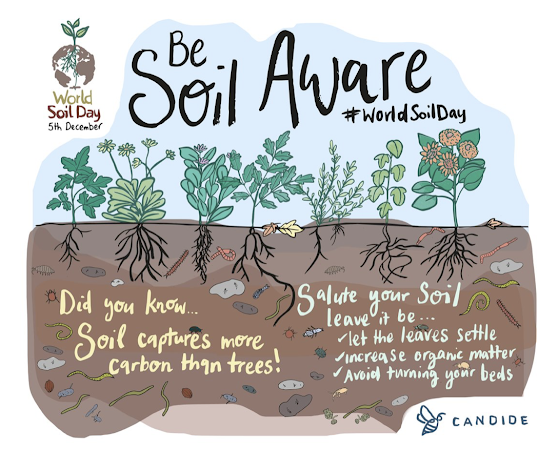Artificial turf contributes to climate change and reduces resilience of Los Gatos in the face of climate-induced weather extremes. Los Gatos, be part of the solution, not part of the problem.
It's December 5th. Happy World Soil Day!
Soil affects the climate that makes our planet habitable. Soil is an essential foundation for all life on Earth!
Let's work together to protect and restore Los Gatos soil health on our private and public properties, and in doing so, help slow changes to our climate and bolster our town's resilience to climate-induced weather extremes.
Artificial turf installations in Los Gatos desertify our soils. Desertification of soil is the permanent degradation of previously fertile land.
Converting a living landscape to artificial turf begins with soil excavation. The ground beneath is then compacted and covered with crushed rock similar to how construction of roads and parking lots begin. On top of that is layered other non-absorbent lifeless materials like, in some cases, a manufactured foam shockpad and finally rugs of green-colored plastic. Life under artificial turf is destroyed.
(The destruction of soil life is, by the way, why LGUSD's landscape designer cautions how expensive and difficult it would be for him to return the fields to natural grass if LGUSD someday does not want to continue with artificial turf fields. Why might LGUSD someday desire to revert to natural grass fields? Perhaps the financial burden of the hefty artificial turf system component replacement costs, likely every 8-10 years going forward to maintain system safety, will be too great. Perhaps artificial turf research that continues to explore the many not-yet-well-understood and not-yet-well-quantified impacts of these systems will uncover more toxicity concerns like the dangerous lead levels found in artificial turf systems prior to 2010.)
By destroying Los Gatos soils with artificial turf, in the following four ways Los Gatos will both contribute to climate change and reduce our local resilience to climate change.
- The native soil excavation process releases carbon into the atmosphere.
- The artificial turf components that blanket the ground permanently prevent carbon sequestration.
- The absence of water-retentive healthy soils contributes to urban heat islands. The absence of vegetation also contributes to urban heat islands.
- The absence of water-retentive healthy soils increases flood risks.
The moisture retained in healthy soil not only reduces soil erosion and helps sustain plant life through dry periods, it enables the evapotranspiration that reduces the urban heat island effect, thereby reducing the need to run energy-guzzling air conditioning units. Vegetation amplifies these benefits. Picture the amount of surface area provided by a field of grass blades. This heat mitigation is especially valuable as climate change brings us heat waves that are more frequent, more intense, and longer lasting.
Soil that is able to hold water is also important because it decreases flood risk in the face of the more extreme storms climate change brings. Healthy soil behaves like a sponge, soaking up rainfall. With impervious surfaces like rooftops, roads, and parking lots, rainfall sheets off and flows towards storm drains. With artificial turf systems, the rainfall winds up routed towards those storm drains. In heavy rainfall, imagine how this can overwhelm storm drain capacity and result in flooding.
If you want to help slow changes to our climate, keep soils healthy and alive so they can sequester carbon. Avoid tilling or excavating soil, avoid leaving soil bare, and avoid killing all soil life by smothering the soil with artificial turf. Instead, protect and nourish soil microbes by keeping soils covered with vegetation (native, drought-tolerant plants where this is practical) and/or decomposing matter. In this way, our living landscapes can provide valuable ecosystem services to Los Gatos.
Along with your kids, learn how to be a Soil Hero by participating in Soil Quest. Below is content from Hero for the Planet's "Soil & Climate" lesson...
Soil Solutions to Climate Problems - Narrated by Michael Pollan on Vimeo.




